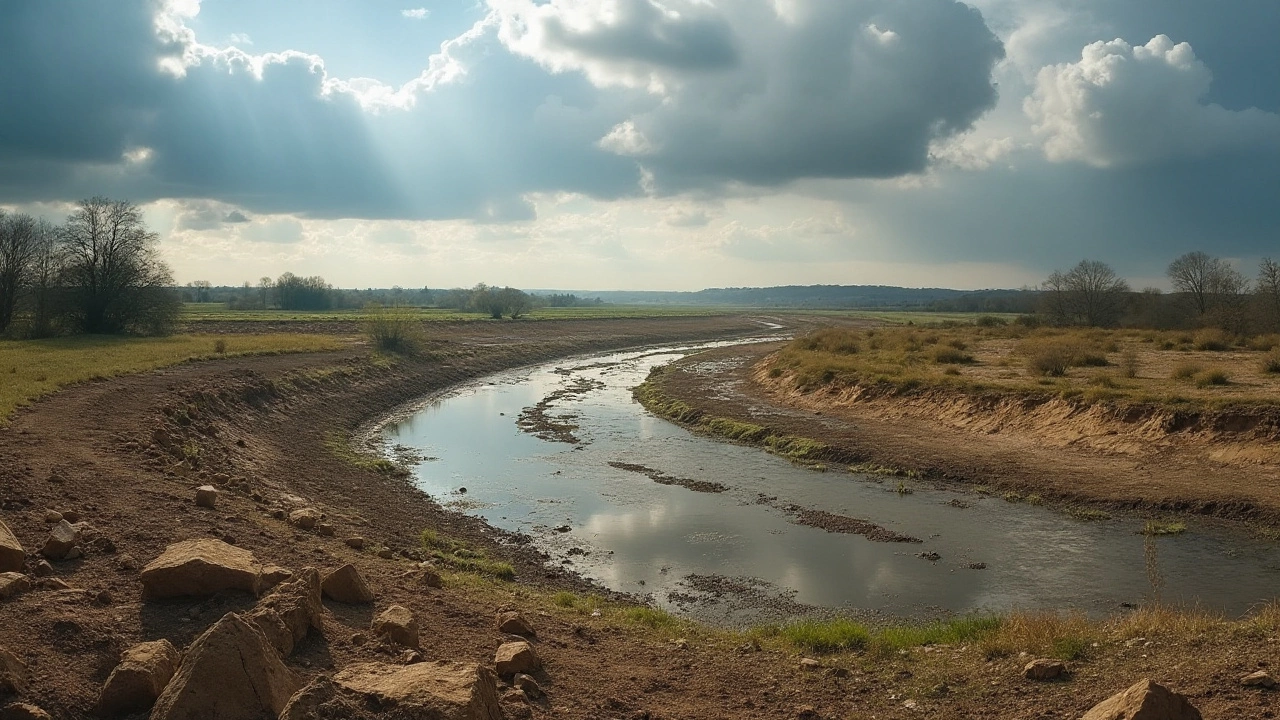Climate change remains a crucial issue that demands our immediate attention. With the escalation of greenhouse gases, our world is experiencing significant changes that threaten ecosystems and human lives alike. It's essential to grasp the meaning, causes, and consequences of climate change to mitigate its negative effects.
Human activities, notably the burning of fossil fuels and deforestation, significantly contribute to the rise in Earth's temperatures. This results in severe weather events, rising sea levels, and drastic impacts on wildlife. Recognizing the urgency of the situation is the first step to inspire collective action. Together, we can leverage sustainable practices to heal and protect our planet.
- Understanding Climate Change
- Consequences of Global Warming
- Human Activities Contributing to Climate Change
- Why Urgent Action Matters
- Steps Towards a Sustainable Future
Understanding Climate Change
Climate change, at its core, refers to significant and lasting changes in the Earth's climate system. This term has been part of scientific discourse for decades but has gained alarming pertinence in the 21st century as the effects become more disruptive. Historically, the Earth's climate has always undergone natural fluctuations; however, what distinguishes current climate change is its accelerated pace and association with human activities. By burning fossil fuels, like coal and oil, we increase concentrations of greenhouse gases in the atmosphere. These gases, including carbon dioxide and methane, trap heat like a thermal blanket, leading to a global temperature rise. Emphasizing the scale of change, a report from the Intergovernmental Panel on Climate Change warns that global temperatures could rise by 1.5 degrees Celsius as early as 2030 if current emission trends continue.
There's immense complexity involved in understanding climate change because it manifests in multifaceted ways, impacting weather patterns, ocean currents, and even wildlife migration. One can't overlook the melting of polar ice caps and sea levels rising, resulting in coastal cities facing the threat of irreversible flooding. Additionally, with changing climates come severe droughts in some regions and intense floods or hurricanes in others. Yet, to comprehend the full scope, one must also consider its socioeconomic implications. The most vulnerable populations—often in developing nations—are disproportionately affected, facing food scarcity and forced displacement. As Nobel Laureate Malala Yousafzai once said,
"Climate change is not just an environmental issue; it is a humanitarian crisis."
The science behind climate change continues to evolve with each new discovery, bolstered by advancements in technology and research methodologies. Satellites, for instance, now provide precise data on atmospheric temperatures and composition. Records reveal that the level of carbon dioxide today is at its highest in at least 800,000 years. This escalation underscores the environmental issues at hand and creates urgency for sustainability initiatives. For those doubting the severity, consider the evidence: the 20th century’s last two decades were among the warmest on record. Climate change is no longer a distant threat; it's an immediate challenge requiring bold action. Understanding the science can empower us to foster change, encouraging policies that prioritize renewable energy and conservation. By gaining insight into this pressing topic, everyone has the opportunity to become part of a solution geared towards ensuring a resilient future for generations to come.
Consequences of Global Warming
The effects of global warming are visible and palpable, transforming our environment in ways we can no longer ignore. As Earth's temperature rises, the climate change phenomenon triggers a domino effect, resulting in extreme weather events. Hurricanes, once occurring sporadically, have become more frequent and violent, leaving destruction in their path. Wetter regions face unprecedented downpours, leading to floods that wipe out communities. Drier areas see the sun mercilessly drying up riverbeds, leading to persistent droughts that parch the land.
Changing climate patterns significantly affect agriculture, threatening food security worldwide. Crops struggle to adapt to new seasonal norms, with heatwaves reducing yields and altering growth cycles. This domino effect touches on the socioeconomic appeals of regions, where the loss of traditional crops destabilizes livelihoods, prompting migration and exacerbating global inequality. A particularly striking image is the sea ice melting, hinting at what scientists have long predicted: oceans are rising as glaciers retreat, threatening to swallow low-lying territories.
"The longer we delay action, the costlier it will be," says Dr. Jane Lubchenco, former Administrator of NOAA. "Addressing environmental issues requires the concerted efforts of policymakers and everyday people alike."
Wildlife doesn’t escape unscathed either. As temperatures shift, countless species are forced to adapt, migrate, or face extinction. Polar bears are perhaps the most publicized victims, struggling to find ice to hunt. Coral reefs, known as the ocean's rainforests, are bleaching and dying at an alarming rate due to warmer sea temperatures. These losses dramatically reshape ecosystems, endangering biodiversity and disrupting intricate food webs.
The urban fabric also feels the heat, literally. Cities become heat islands, with concrete and asphalt absorbing the sun's rays, leading to stifling conditions that strain public health and infrastructure. Residents wrestle with heatwaves, exacerbating chronic issues such as respiratory disorders as air quality diminishes. It's clear that the nature of these threats demonstrates the urgent need for sustainable practices.
While these facts illustrate a grim reality, they also underline why immediate action is necessary. Recognizing these varied consequences, from ecological damage to human hardships, communities can rally under shared goals to demand smarter, ecofriendly policies. This essential awareness builds the foundation for actionable insights, furthering efforts toward achieving long-term sustainability.

Human Activities Contributing to Climate Change
Climate change, largely driven by human activities, is an intricate web spun from a tapestry of industrialization, globalization, and technology. One of the primary culprits is the burning of fossil fuels such as coal, oil, and natural gas, which are used extensively for electricity generation, heating, and powering vehicles. When we burn fossil fuels, carbon dioxide (CO2), a major greenhouse gas, is released into the atmosphere. This process traps heat, leading to a warming Earth, which is a major piece of the climate change puzzle. Interestingly, studies show that CO2 levels have risen by over 40% since the pre-industrial era, highlighting the profound impact of industrial advancements on our ecological impact.
Deforestation is another critical factor impacting climate change. Forests act as 'carbon sinks', absorbing more CO2 than they emit. However, when trees are cut down or burned, this stored carbon is released back into the atmosphere. Every year, approximately 15 billion trees are lost, exacerbating the problem further. Land use changes, such as agricultural expansion and urban sprawl, also lead to soil degradation, affecting local climates and biodiversity. Agriculture, while critical to feeding the world's population, is also a significant contributor, as processes like rice cultivation and livestock rearing emit methane, another potent greenhouse gas.
Beyond what happens on the ground, the aviation and shipping industries significantly contribute to climate change. Airplanes release large quantities of CO2 and nitrogen oxides high into the atmosphere, accelerating warming effects. Shipping, crucial for global commerce, contributes by not just releasing CO2, but also sulfur aerosols, which adversely affect marine and coastal environments. These industries are often overlooked despite their substantial carbon footprints. Notably, modern technology has provided some respite. Renewable energy sources such as wind, solar, and hydroelectric power are on the rise, offering less polluting alternatives. Encouragingly, over a quarter of electricity generated globally in 2023 was from renewable sources.
According to the Intergovernmental Panel on Climate Change (IPCC), "Limiting global warming will require major transitions in the energy sector. This includes a substantial reduction in fossil fuel use, widespread electrification, improved energy efficiency, and the use of alternative fuels."
In examining the role of consumer habits, the production and disposal of goods cannot be overlooked. The fast-fashion industry is a notable example, responsible for about 10% of global carbon emissions. Meanwhile, the burgeoning e-commerce sector increases the demand for packaging and deliveries, indirectly swaying energy consumption patterns. Individuals can make a collective difference by opting for sustainable products and reducing waste. Additionally, city traffic and transportation systems add layers to this issue, with cars contributing significantly to environmental issues. Encouraging the use of public transportation, cycling, and walking can be effective strategies to curb emissions. Notably, vehicle emissions standards are tightening worldwide, showcasing a shift in policy designed to tackle these emissions head-on.
Why Urgent Action Matters
As we stand at the crossroads of decision-making regarding our environmental legacy, the importance of prompt action against climate change has never been more pressing. The effects of global warming are not distant threats; they are occurring now, inflicting harsh realities on communities around the world. Extreme weather events like hurricanes, wildfires, and floods are becoming alarmingly frequent, causing devastation to both human and natural habitats. These changes aren't merely interruptions to our daily lives—they signify shifts in environmental conditions that may soon become the norm if left unchecked. Among the ramifications include the displacement of populations, compromised food security, and significant financial costs to governments and individuals, all of which demand immediate and effective responses to mitigate their impact.
Indeed, failing to address climate change rapidly intensifies the risks we face. Melting ice caps and glaciers contribute to rising sea levels, which threaten coastal cities and small island nations globally. According to NASA, the sea level has risen by about eight inches since 1880. As natural barriers like coral reefs deteriorate due to warming oceans, the protection they offer to coastlines diminishes, leaving communities exposed to the full force of storm surges. Biodiversity is also at stake; habitats are being altered faster than many species can adapt, leading to a loss of biodiversity that disturbs ecological balance.
The data speaks for itself: The Intergovernmental Panel on Climate Change (IPCC) has repeatedly warned that limiting global warming to 1.5°C is critical to prevent some of the worst impacts of climate change. Achieving this target necessitates profound and comprehensive measures, including reducing carbon dioxide emissions by 45% from 2010 levels by 2030—an endeavor that requires swift and coordinated global effort. Ongoing inaction paints a dire future portrait, accelerating the timeframe for irreversible changes. Immediate and robust initiatives can help avert these prognostications, as proactive measures often cost less than the reactive interventions required after disaster strikes.
"The clock is ticking on the lasting impacts of climate change. Our actions today will determine the safety and quality of life for generations to come," said António Guterres, Secretary-General of the United Nations.
Embracing sustainable policies and technologies represents a viable path forward, promising economic opportunities alongside their environmental benefits. Transitioning to renewable energy sources not only cuts emissions but also stimulates job creation and advances energy independence. Encouraging sustainable agricultural practices helps maintain the vital equilibrium of ecosystems while ensuring food security. Cities worldwide are becoming arenas of innovation and adaptation, where local governments implement eco-friendly infrastructure projects that serve as models for sustainability, highlighting that change, although complex, is achievable.
In summary, addressing the challenges posed by climate change is not merely an act of environmental stewardship but a necessity for human survival and well-being. Urgent actions are imperative to curtail the growing obstacles and irreparable damage we will otherwise face. Each step taken toward sustainability contributes to a cumulative effect which accommodates not just the present, but also protects the sanctity of nature for all future generations.

Steps Towards a Sustainable Future
Creating a sustainable future involves a collective effort toward reimagining our interactions with the environment. By focusing on responsible actions and policy changes, we can address the most pressing of our environmental issues. For instance, enhancing energy efficiency and transitioning to renewable energy sources like solar and wind play pivotal roles in reducing our reliance on fossil fuels. These clean energy alternatives not only curb carbon emissions but also pave the way for innovation in sustainable technologies.
Implementing sustainable agricultural practices is equally crucial. The agriculture sector, a significant contributor to climate change due to methane and other emissions, can shift towards practices such as crop rotation and permaculture to enhance soil health and reduce emissions. Moreover, supporting local food systems not only minimizes transport emissions but also enriches community resilience. The adoption of a plant-based diet is growing in popularity as a personal step towards sustainability, significantly reducing one's carbon footprint.
Community and Policy Initiatives
Community-driven initiatives often yield inspiring results. Individuals can foster change by participating in local environmental groups that advocate for sustainable practices and push for legislative changes. For instance, municipalities can implement public transportation improvements and build infrastructure for greener economies. Involving local stakeholders and maintaining transparency play key roles in the successful execution of sustainable policies. A global initiative worth noting is the Paris Agreement, a legally binding international treaty on climate change aimed at limiting global warming. Its success hinges on national commitments and grassroots activism.
"The greatest threat to our planet is the belief that someone else will save it." - Robert Swan, environmental advocate
Role of Education and Technology
Education is an empowering tool that we must wield effectively. By integrating sustainability concepts into school curricula, we guide future generations in environmentally responsible decision-making. Educational campaigns raise awareness about climate change and inspire action across communities. Technology, meanwhile, has the potential to catalyze change. At the intersection of digital innovation and sustainability, technologies like AI and IoT monitor environmental impacts and optimize resources.
An open door for innovations lies in the concept of a circular economy, which challenges the traditional 'take-make-dispose' model. Instead, resources are reused and recycled, minimizing waste. In Sweden, for example, government incentives for repair and recycling have led to a cultural shift towards more sustainable consumption patterns. Practical steps include more robust urban planning aligned with ecological objectives, thereby ensuring cities are equipped to deal with rapid growth without compromising ecological integrity.
The evidence is clear: turning our attention towards specific, actionable steps promises a mutually beneficial path for humans and ecosystems. By incentivizing green energy, supporting sustainable agriculture, and fostering local and global cooperation, we chart a course for a more sustainable future. This action will undoubtedly contribute to reversing damaging environmental trends and ensuring that our planet remains vibrant for generations to come.
